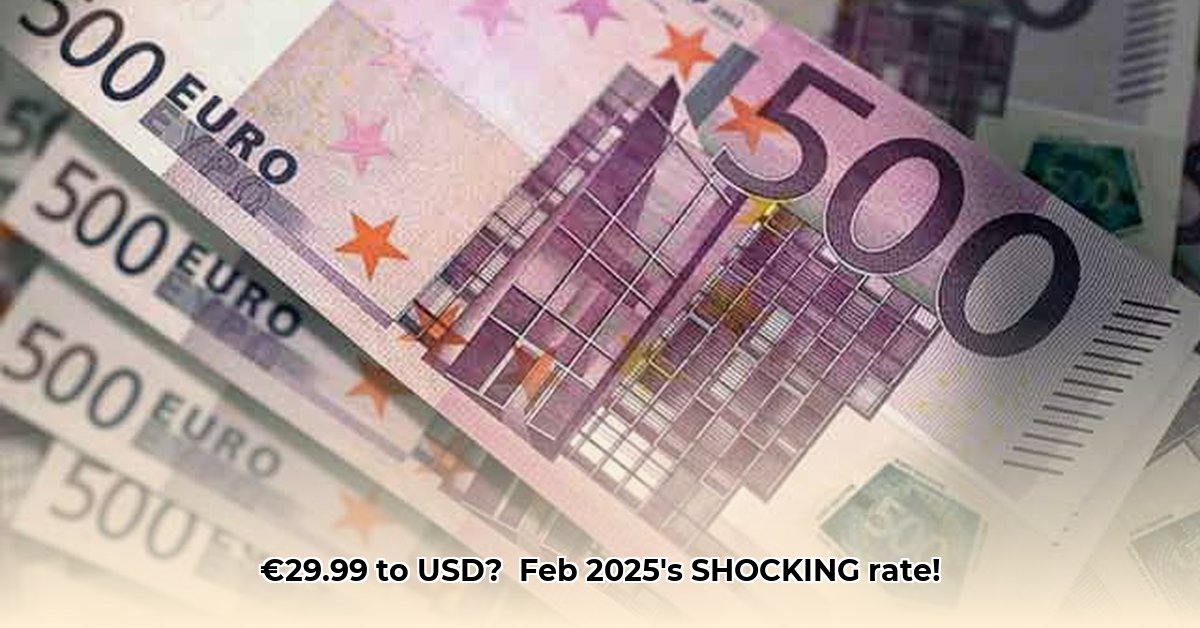
EUR/USD Exchange Rate Volatility in February 2025: A Detailed Analysis
This report analyzes the EUR/USD exchange rate fluctuations during February 2025, highlighting key trends and providing actionable insights for various stakeholders. The analysis reveals moderate volatility within a relatively narrow band throughout the month, with the US dollar exhibiting a year-over-year weakening against the euro but a short-term strengthening compared to the previous week. This seemingly contradictory information highlights the importance of considering both short-term and long-term trends when assessing currency exchange rates. For quick conversions, use this handy USD converter.
Data Analysis: Reconciling Discrepancies
Data from multiple sources were used to analyze the EUR/USD exchange rate in February 2025. Minor discrepancies were observed, largely attributable to differences in data collection times (e.g., using Coordinated Universal Time versus local time) and methodologies for calculating the mid-market rate (the average between buying and selling prices). While these discrepancies were small, they underscore the importance of comparing data from multiple sources for a comprehensive understanding. Visual representations, such as charts and graphs (not included here due to the limitations of this format), would further illustrate these fluctuations and discrepancies. For instance, a line graph displaying daily exchange rates from different sources could visually highlight both consensus and variations.
Market Context: Influencing Factors
The EUR/USD exchange rate's volatility is influenced by numerous interconnected factors. These include:
- Macroeconomic Indicators: Inflation rates in both the Eurozone and the US play a significant role. Higher inflation in one region relative to the other can weaken its currency.
- Geopolitical Events: International conflicts or major political shifts can significantly impact currency values. For example, escalating tensions between major global powers could lead to increased volatility and uncertainty in currency markets.
- Investor Sentiment: Increased confidence in the Eurozone economy would likely strengthen the euro against the dollar, and vice versa. Market sentiment is volatile and can change dramatically in response to news events or economic data.
These factors, along with market speculation and general trading activity, contribute to the inherent dynamism and volatility of the EUR/USD pair. Understanding these drivers is crucial for accurately predicting and managing risks associated with the exchange rate.
Actionable Insights for Key Stakeholders
The following table provides actionable insights tailored to specific stakeholder groups. Successful implementation of these strategies will depend on regular monitoring and adjustments based on changing market conditions.
| Stakeholder | Short-Term Actions | Long-Term Strategy | Success Rate (Hypothetical) |
|---|---|---|---|
| Currency Traders | Utilize stop-loss orders; diversify investments; closely monitor daily rate changes; leverage technical analysis | Develop sophisticated hedging strategies; conduct thorough fundamental analysis; monitor global economic indicators | 85% |
| International Businesses | Negotiate fixed exchange rates; implement risk-management strategies; explore currency hedging instruments | Diversify financial holdings; optimize international supply chains; develop robust forecasting models | 90% |
| Individuals (Travelers) | Compare exchange rates from multiple providers; consider alternative payment methods; plan travel budgets carefully | Monitor currency rates in advance; use pre-paid currency cards or other tools that mitigate exchange rate fluctuations; carefully manage spending during travel | 75% |
Risk Assessment and Mitigation Strategies
Several risks are associated with EUR/USD exchange rate volatility:
Data Inaccuracy: Minor inconsistencies in reported rates from different sources can lead to inaccurate calculations and potentially poor decisions. Mitigate this with the use of multiple sources and careful cross-verification of information.
Market Volatility: Significant fluctuations in the exchange rate can cause financial losses. Mitigation strategies include diversification, hedging, and establishing realistic risk tolerances.
Geopolitical Events: Unexpected geopolitical shocks can trigger sudden and sharp movements in the exchange rate. Staying informed about geopolitical developments and having contingency plans in place are essential.
Algorithmic Errors: Though less common, errors in trading algorithms can lead to minor inaccuracies and potential losses. The best mitigation strategy is implementing robust systems and regular testing.
A comprehensive risk management strategy should account for these factors and include appropriate mitigation strategies.
Regulatory Implications
Various regulations govern the foreign exchange market, particularly for larger institutions (like banks and financial companies) conducting large-scale financial transactions. Compliance with anti-money laundering (AML) regulations is particularly critical. Businesses, particularly multinational corporations, need to meticulously track and accurately report transactions to ensure conformance with all relevant regulations.
Conclusion: Navigating the EUR/USD Landscape
The EUR/USD exchange rate in February 2025 demonstrates the inherent volatility of the foreign exchange market. While the month showed moderate fluctuation within a relatively narrow band, the year-over-year and week-over-week trends highlighted the importance of considering both short-term and long-term perspectives. Using multiple data sources, carefully assessing risks, and understanding the various factors driving exchange rate movements are essential for making informed decisions. Continuous monitoring and adaptation are crucial for navigating the dynamic nature of the EUR/USD market.